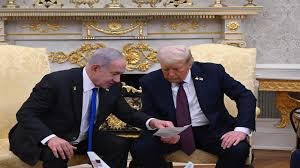

Trump Gaza Peace Plan: Deaths Mount, Risk Grows
In a dramatic development amid worsening violence, U.S. President Donald Trump unveiled a 20-point peace plan to end the brutal two-year war between Israel and Hamas. Announced alongside Israeli Prime Minister Benjamin Netanyahu on September 29, the proposal arrives as Gaza teeters on the brink of collapse. More than 66,000 Palestinians have lost their lives since the conflict reignited, with nearly 170,000 injured, according to international reports. The deepening humanitarian catastrophe has drawn global condemnation and intensified calls for a decisive and urgent resolution.
Trump’s plan, drafted by his Middle East envoy Steve Witkoff and son-in-law Jared Kushner, envisions a phased Israeli withdrawal from Gaza. In its place, a transitional governing authority-comprising non-political Palestinian technocrats and international experts—would oversee Gaza’s reconstruction. An International Stabilization Force (ISF), including Arab and global peacekeeping partners, would maintain security.
The blueprint demands that Hamas disarm, relinquish political control, and release all hostages within 72 hours. In exchange, Israel would halt offensive operations, release over 1,900 prisoners, and commit to rebuilding Gaza-without displacing its residents.
However, critics argue the plan heavily favors Israel. Israel retains control over the withdrawal timeline, and the plan lacks enforcement mechanisms or a commitment to dismantle Israeli settlements. Importantly, there is no defined pathway to Palestinian statehood—only a conditional, vague roadmap.
Why Now — And Why Not Before?
The timing of Trump’s intervention has sparked sharp questions. If peace was always the goal, why didn’t this plan come earlier—during his previous term or in the early stages of the conflict?
The answer lies in shifting regional dynamics and political opportunity. Earlier in his presidency, Trump’s decisions-such as recognising Jerusalem as Israel’s capital, halting aid to UNRWA, and backing Israeli annexation efforts—alienated Palestinian leadership and shattered trust. Meanwhile, Netanyahu faced pressure from Israel’s hard-right factions, and Hamas had shown zero willingness to negotiate under perceived coercion.
But now, the scale of the humanitarian crisis and risk of regional escalation have changed the equation. With Israeli airstrikes hitting Iran, Lebanon, Syria, Yemen, and even Qatar, the threat of a broader Middle East war has become imminent. Trump’s intervention serves two purposes: contain the conflict diplomatically and reassert U.S. influence in a region where credibility has declined.
There are also domestic political incentives. Trump, potentially preparing for a return to the White House, seeks to brand himself as a global statesman and dealmaker. For Netanyahu-whose approval ratings are slipping and political alliances strained-a viable peace deal could be a lifeline.

A seasoned journalist with over 30 years of rich and diverse experience in print and electronic media, Prabha’s professional stints include working with Sahara English Magazine, Pioneer and JAIN TV and All India Radio. She has also been writing in Pioneer. She has also produced several documentary films through her self-owned production house Gajpati Communications. She is also the Station Director of Aligarh-based FM Radio Station, and the General Secretary of WADA NGO.









